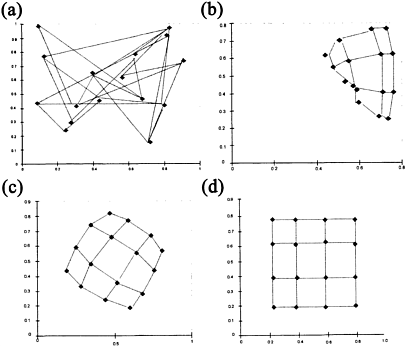26.
| [Cover] [Contents] [Index] |
Page 120
The second step of this process requires more time than the first step. To help understanding of the behaviour of the SOM, two examples are presented below.
In the first example, 65,536 samples, which are uniformly distributed on a two-dimensional space within the range [0, 1] on each co-ordinate axis are input to a SOM for unsupervised training. The SOM was constructed by using two neurones in the input layer, and 4×4 neurones for the output layer. Figure 3.8 shows the weight distribution output by the SOM. The symbol ‘◆’ indicates the location of the output neurones in terms of associated weights (i.e. in feature space). The lines in Figure 3.8 show the links between spatially adjacent neurones.
Before training begins, the weights are initialised to random values within the range [0, 1] (Figure 3.8a). After ten iterations, the SOM weights start to expand (Figure 3.8b). After 1,000 iterations, the ordering between input patterns can roughly be seen by the topology made up by output neurones and weights as shown in Figure 3.8c. After 6,000 iterations, the weights are approximately uniformly spread as illustrated in Figure 3.8d.
Figure 3.9 shows a second example in which the number of test data points and the feature ranges are the same as in example 1. However, a slight change is made so that 75% of the random samples fall in the shaded area (Figure 3.9a). The resulting distribution of weights after 6,000 iter

Figure 3.8 (a) Random initial weights, (b) Weights after ten iterations, (c) Weights after 1000 iterations, (d) Weights after 6000 iterations. See text for details.
| [Cover] [Contents] [Index] |
EAN: 2147483647
Pages: 354